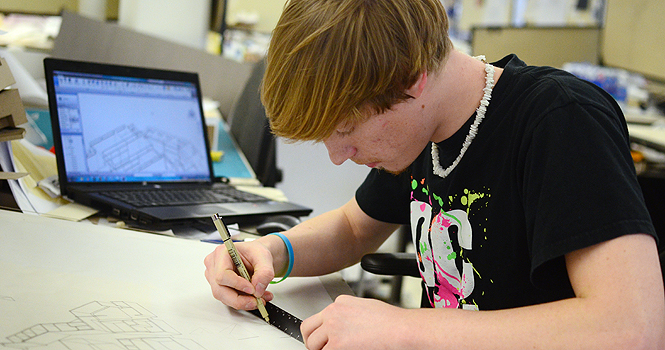Students in high-stress majors try to balance sleep and homework
Andrew Sansone, sophomore architecture major, works on a project in Taylor Hall on April 25. Photo by Nancy Urchak.
April 26, 2012
Kurt Lehecka was 5 years old when he started flipping through his cousin’s architecture textbooks. His cousin warned him about the all-nighters and the heavy amounts of work the major demands, but Lehecka said “ever since then, it was the one thing I had my mind set on.”
Lehecka, now a junior architecture major and honors student, said his cousin was right. He spent 70 hours working in the architecture studio last week constructing a model recreational center with an indoor and outdoor pool for his Secondary Design Studio class.
“All of the fourth floor of Taylor (home of the College of Architecture and Environmental Design) is just filled,” Lehecka said. “It’s just full of kids who are kind of loopy because we haven’t gotten enough sleep.”
Students typically dread spending hours studying for finals week, but for those in majors like Lehecka’s, time-consuming final projects replace exams.
Brooke Harrison, a sophomore fashion design major, sat in a Rockwell Hall studio Monday night piecing together a black wool jacket. The garment is the final project for her workroom class, and Harrison anticipated staying up all night to finish it.
“I ended up messing up this one part of it and it was one of the beginning steps and I didn’t know I messed it up till I was working on another part,” Harrison said. “So, I had to basically take out a bunch of stuff and start close to the beginning.”
Harrison said spending late nights finishing projects and fixing mistakes isn’t uncommon.
“I have a 7:45 [a.m. class] three times a week, so it sucks. I get, like, three hours of sleep on those days,” Harrison said. “I’ll just have some caffeine, and sometimes I’ll take a quick nap during the day between class if I know I have to stay up late.”
Harrison said people overlook the time and effort she puts into her projects because her major is very hands-on.
Harrison is concerned because she had a few trips to the hospital this semester, which put her behind in a lot of her classes. Final projects are very important to Harrison because they determine whether she advances in the fashion program and she is already a year behind.
“It’s a lot more than I thought,” Harrison said. “I guess I didn’t really know what to expect at all.”
Noel Palomo-Lovinski, fashion design and merchandising associate professor, recalled her days as a student at Parsons School of Design and said its program was just as difficult and time-consuming.
“I remember crying in class from frustration and lack of sleep,” Palomo-Lovinski said. “My teacher pulled me in the hall and said ‘Remember it is fashion, not nuclear war.’ It is advice I repeat often to my own students.”
Grace Schottelkotte, sophomore visual communications design major and honors student, has made the same kind of commitment to her final project.
Schottelkotte spent most of her weekend taking and editing photographs of thumbtacks for her Photo Technology class. Now, she’s creating a website for her intermediate computer class and spent around two hours just to create the navigation bar at the top of the webpage.
“It is a very time-consuming major,” Schottelkotte said. “So if you don’t have time management skills, I don’t think you can do it.”
Schottelkotte said that she puts a lot of effort into her projects, and “if you just look at it as someone else who’s not in the major, you don’t get it.”
“It’s working creatively rather than working from a set of rules, because VCD is what you put into it, whereas for math and science majors, it’s more of how you use what you’re given,” Shottelkotte said. “I think the difference lies in the fact that it’s creation versus knowledge.”
Schottelkotte said her major is also different from others because she is always thinking about her projects, even when she isn’t working on them.
“I’m always thinking about my designs in my head,” Schottelkotte said. “‘How can I do this? What’s best to show this?’ There’s always something you’re thinking about in relation to your project … Being a design major, it’s a way of life.”
Jason Miller, Counseling and Human Development Center clinic director, said he believes workloads seem manageable at the beginning of the semester, but pile up by the end.
“While time management will not eliminate stress from school completely, effectively managing time, such as developing and adhering to a schedule for working on a project, can reduce the stress that comes from the time crunch at the end of a semester and aid students in getting a good night’s sleep,” Miller said.
Contact Alyssa Morlacci at [email protected].

























